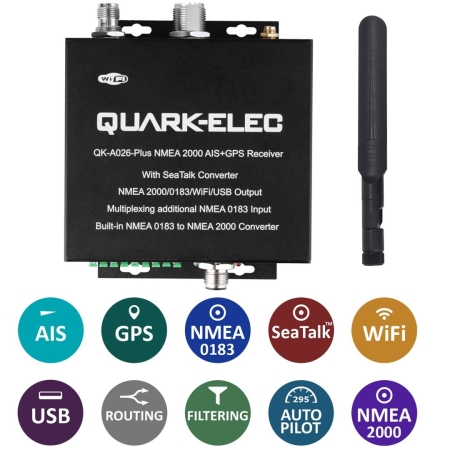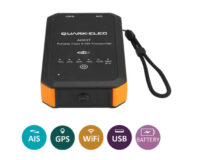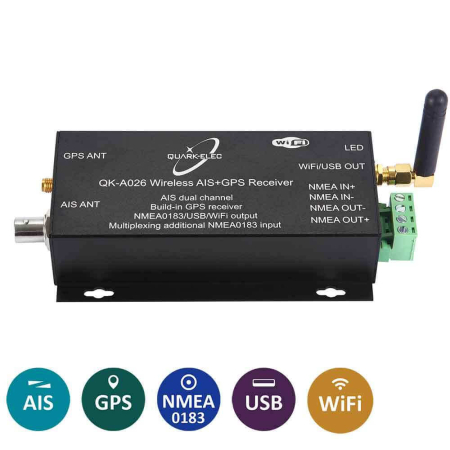A WiFi multiplexer is the traffic controller and translator of on-board data. It collects information from all your instruments, combines it and communicates it clearly. Moreover, it makes the data available via WiFi on tablets, phones and laptops.
Table of contents
What is a WiFi multiplexer?
A WiFi multiplexer is the traffic controller and translator of on-board data. It collects information from all your instruments, combines it and communicates it in a clear way. Moreover, it makes the data available via WiFi on tablets, phones and laptops.

Why do you need a multiplexer on board?
On a modern boat, there are more and more electronics. Navigation, safety and comfort all lean on data from instruments. Without a multiplexer, it is often difficult to share and combine that data neatly.
Typical problems are:
❌ Devices sending data at the same time causing messages to be lost,
❌ Older equipment (e.g. NASA Marine, Raymarine ST series) that only speaks NMEA0183 or SeaTalk,
❌ New instruments that correctly use NMEA2000 or SeaTalk NG,
❌ Displays of older equipment that are limited or poorly readable.
The solution: a WiFi multiplexer.
✅ It combines and organises all incoming messages, eliminating conflicts.
✅ He translates between protocols, so old and new devices suddenly do work together.
✅ Thanks to WiFi, you can display data directly on a modern app, making a tablet or smartphone act as a bright and versatile display.
Without a multiplexer, you have separate islands of instruments. With a multiplexer, they form one integrated network, visible on modern screens.
How does a multiplexer technically work?
The principle is simple: several inputs come together in one device, which processes the messages and relays them via one or more outputs.
Key features include:
- Buffering:incoming data is temporarily stored and forwarded at the appropriate time.
- Orderly combining: messages from different sources are merged.
- Conflict resolution: if two devices are "talking" at the same time, the multiplexer decides which information has priority.
- Conversion of protocols: Besides combining, a multiplexer can also convert data. This allows older equipment (e.g. NMEA0183 or Raymarine SeaTalk) to be translated to modern standards such as NMEA2000 or SeaTalk NG. This allows systems that are normally not compatible to work together.
- Output to multiple channels: for example, one physical output to the chartplotter and at the same time wirelessly via WiFi to your iPad.
Which protocols are supported?
Multiplexers work with the major maritime protocols:
| NMEA0183 | Classical, still widely used with older instruments |
|---|---|
| NMEA2000 (N2K) | Modern, faster and more flexible |
| SeaTalk / SeaTalk NG | Especially with Raymarine equipment |
A multiplexer can often use these protocols interchangeably and even convert to each other.
The usefulness of WiFi outlets
More and more water sports enthusiasts are using a tablet or smartphone as an additional navigation screen. Think of apps such as Waterkaarten app, Navionics, WinGPS, NV Charts or OpenCPN.
With a WiFi multiplexer, you can:
👍🏻 live view anywhere on board including AIS, GPS, Wind and depth data, etc,
👍🏻 connect multiple devices simultaneously (e.g. iPad on the cockpit table as well as a phone as backup),
👍🏻 save cables - useful for larger or existing installations and in terms of flexibility.
Filtering and priority: order in the data stream
Not all data is always equally important. Suppose you have multiple GPS sources. Then you have to choose which is the primary one, otherwise your plotter will get confused.
The top-of-the-range multiplexers therefore offer filtering and priority:
- you can set which messages go through or not,
- duplicate data can be filtered out,
- important information (e.g. AIS and primary GPS) is always given priority.

Quark-Elec
British brand Quark-Elec is one of the best-known suppliers of WiFi multiplexers.
Their products are known for:
✅ compact design
✅ broad support for protocols
✅ ease of use (often plug-and-play)
✅ favourable price compared to high-end solutions
They mainly target the recreational and semi-professional market, with models ranging from simple multiplexers to complete units with built-in AIS receiver or GPS.
Examples of commonly used models:
| A031 | NMEA0183 + SeaTalk → WiFi |
|---|---|
| A032 | NMEA0183 + NMEA2000 + USB |
| A034-B | bi-directional, also suitable for autopilot |
| A026-Plus / A027-Plus | multiplexer + AIS + GPS in one |
-
Deal!
Quark-Elec A031 WiFi Multiplexer with SeaTalk + NMEA0183
0 Reviews€ 159,00Oorspronkelijke prijs was: € 159,00.€ 129,00Huidige prijs is: € 129,00. -
Deal!
Quark-Elec A032 NMEA 2000/0183 Bi-dir -USB +WiFi
0 Reviews€ 189,00Oorspronkelijke prijs was: € 189,00.€ 179,00Huidige prijs is: € 179,00. -
Deal!
Quark-Elec A034-B Bi-Dir WiFi Multiplexer with SeaTalk +N2K +NMEA
0 Reviews€ 309,00Oorspronkelijke prijs was: € 309,00.€ 299,00Huidige prijs is: € 299,00. -
Deal!
Quark-Elec A026-Plus NMEA(2000) AIS-GPS Multiplexer + WiFi
0 Reviews€ 359,00Oorspronkelijke prijs was: € 359,00.€ 339,00Huidige prijs is: € 339,00. -
Deal!
Quark-Elec A027-Plus NMEA(2000) AIS-GPS multiplexer with N2K converter + WiFi + LAN
0 Reviews€ 309,00Oorspronkelijke prijs was: € 309,00.€ 299,00Huidige prijs is: € 299,00.
Installation in practice
- Mount the multiplexer in a dry place.
- Use good cables and ensure grounding.
- Test everything loose before final installation.
- Note which input is connected to which instrument.
- Check firmware updates for stability and new features.
Tips on use and maintenance
- Use filtering to remove "noise" from the data stream.
- Secure the WiFi with a password.
- Keep a diagram of your installation.
- After updates to navigation apps, check whether the link still works.
Frequently asked questions
Can I connect multiple devices at the same time via WiFi?
Yes, usually 2-3 devices at a time, depending on the model.
Can I also pair the multiplexer with my on-board router or hotspot?
Yes! Put the multiplexer in station mode and it links to an existing router or hotspot. This gives you both access to your onboard instruments and the internet - ideal for combined boat data with weather and chart updates online.
Does it also work with older equipment?
Yes, you can combine NASA Marine, Raymarine ST-series and other older systems with modern NMEA2000 or SeaTalk NG. This allows brands that do not normally work together to communicate with each other.
Is the WiFi connection secure?
Yes, the connection can be password-protected, just like your home network.
Can I also send back commands?
Bi-directional models do, for example to the autopilot.
Compatibility with older equipment
One of the great advantages of plywooders is that you can combine old and new systems. Where previously NASA Marine or Raymarine ST series could only talk to each other, thanks to the multiplexer they can now cooperate with NMEA2000 and SeaTalk NG networks. So you don't have to replace your old instruments right away, just seamlessly insert them into your modern on-board system.

Baudrates and institutions
With NMEA0183, the baud rate (the speed of data communication) plays an important role. Some devices operate at 4800 baud (classic standard), while AIS, for example, often requires 38,400 baud.
✔️ A multiplexer can combine these different speeds. With the configuration tool easily set the correct baud rates per port. This allows each instrument to operate at its own speed, without conflicts.
Autopilot control via mobile
Quark-Elec's top models offer just one more step: you can use the control your autopilot from your mobile or tablet. Via an app, you can report course changes, for instance, without having to physically stand at the control panel. This provides comfort and safety, especially when sailing alone.
Dashboard apps & cheap displays on tablet
Another great value of the WiFi option is that you can use your tablet or phone as a dashboard display, with apps such as NMEAremote or WilhelmSK.
Two apps as examples:
 WilhelmSK is an app (for iOS) that works with the Signal K protocol and is very flexible in creating dashboards. You can add gauges such as depth, wind speed, rudder position, log/speed etc.
WilhelmSK is an app (for iOS) that works with the Signal K protocol and is very flexible in creating dashboards. You can add gauges such as depth, wind speed, rudder position, log/speed etc.
 NMEAremote is also popular: it displays real-time data from your instruments via WiFi, with customisable dashboards, easy-to-read gauges, alarms, etc.
NMEAremote is also popular: it displays real-time data from your instruments via WiFi, with customisable dashboards, easy-to-read gauges, alarms, etc.
This way, it is budget-friendly to show your depth gauge, wind meter, log/speed, rudder position, etc. on a tablet, without expensive displays from manufacturers such as Raymarine, B&G or Simrad. So you are not stuck with a branded ecosystem.
The options are many: you choose the app, the layout, the data fields, and often you can expand or modify it later.
WiFi means no internet
A common misconception is that you need internet to use a WiFi multiplexer. This is not so.
The multiplexer creates its own wireless network. Your tablet or smartphone connects to that network, just as you connect to your router at home. The difference: here, the data comes from your on-board instruments and not from the internet.
In other words: WiFi here simply means wireless. All your instrument data goes through a WiFi connection to your tablet or phone, without an internet connection.
If you also want to use the internet (e.g. for weather maps), you can do so by using the multiplexer in station mode connect to an on-board router or hotspot.
A WiFi multiplexer is the key to a smart and clear on-board network
It combines, converts, filters and distributes all the data from your instruments, makes brands and generations compatible, and ensures you have access to up-to-date information everywhere.
From older NASA and Raymarine ST equipment to modern NMEA2000 networks: with a multiplexer, everything talks together. Add WiFi, filtering, flexible baud rates, autopilot control ánd dashboards on your tablet with apps like WilhelmSK, NMEA Dashboard or NMEAremote - and you have a system that is powerful, flexible ánd affordable.












